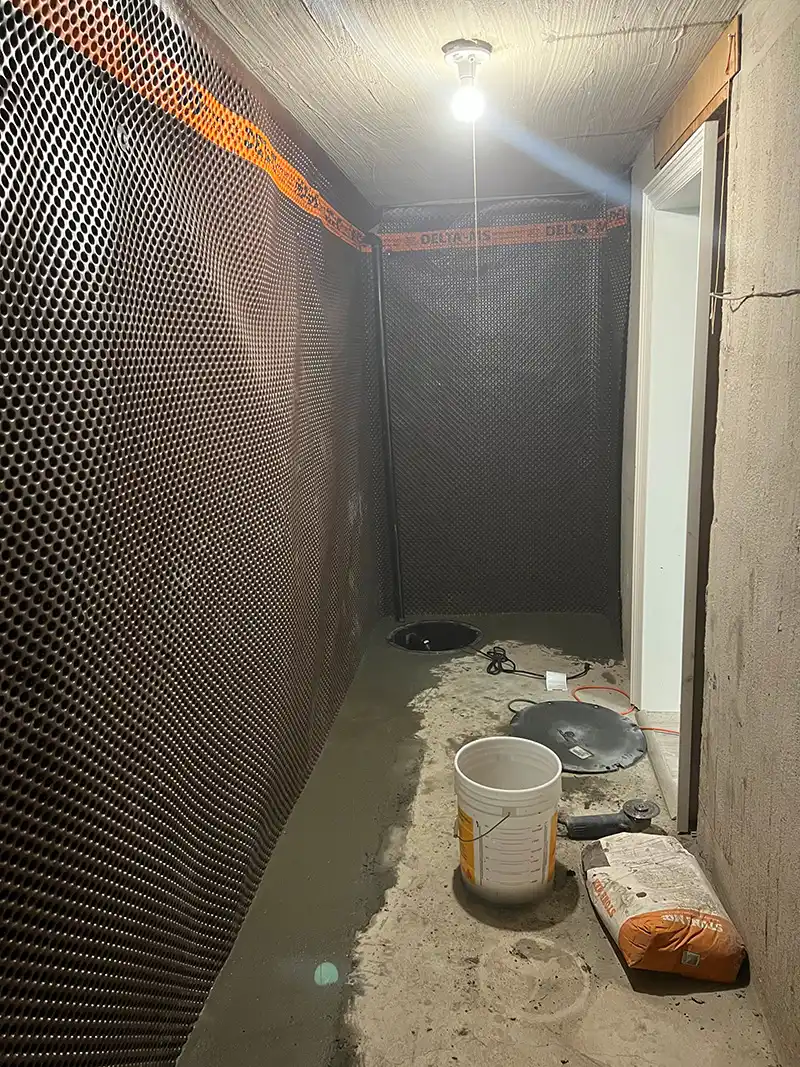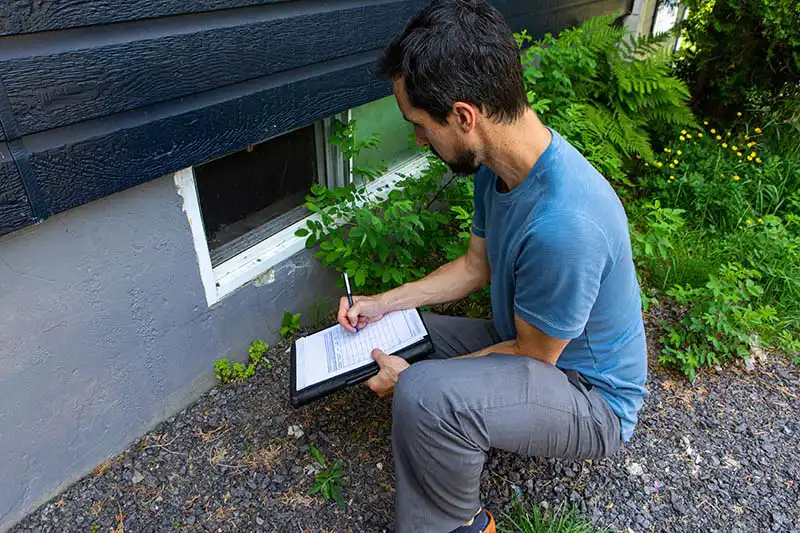Leaky Basement? Damp Walls or Musty Smell?
At DrySpace, we understand every basement is unique. That's why we offer a range of tailored interior waterproofing solutions to address your specific needs effectively and permanently.
-
Interior Foundation Inspection
FreeSuspect a leak or moisture in your basement? Our experts will conduct a thorough interior inspection to identify the source of the problem and recommend the best solutions to keep your basement dry.
Learn More -
Interior Basement Waterproofing
$60 - $200 per linear ft.Our interior basement waterproofing solutions prevent water from entering your basement by managing it effectively from the inside. Ideal for properties where exterior excavation is not possible.
Learn More -
Sump Pump Installation
$1000-$2500A sump pump is essential for preventing water accumulation in your basement. Our team installs reliable sump pumps that efficiently remove water, keeping your basement dry even during heavy rainfall. The cost for sump pump installation in Toronto generally ranges from $1,000 to $2,500.
Learn More -
BackWater Valve Installation
$1500-$3000Protect your home from sewer backups with our back water valve installation service. This crucial device prevents sewage from flowing back into your basement, safeguarding your property from potential damage and health hazards. Installation costs for back water valves in Toronto typically range from $1,500 to $3,000.
Learn More -
Concrete Slab Crack Injection
$500-$1500Cracks in your concrete slab can lead to water seepage and structural issues. Our concrete slab crack injection service effectively seals these cracks, preventing water from entering and maintaining the integrity of your foundation. Prices for this service in Toronto usually range from $500 to $1,500 per crack.
Learn More -
Foundation Wall Crack Injection
$500-$1500Foundation wall cracks can compromise the stability of your home. Our foundation wall crack injection service addresses these issues by sealing cracks and preventing water infiltration, ensuring the strength and durability of your foundation. The cost for foundation wall crack injection in Toronto generally ranges from $500 to $1,500 per crack.
Learn More -
Drains Installation
$2000-$5000Proper drainage is vital for preventing water buildup around your home. We offer professional drain installation services to direct water away from your foundation, reducing the risk of basement flooding. Drain installation costs in Toronto typically range from $2,000 to $5,000.
Learn More -
Concrete Floor Pour
$5000If your basement floor needs repair or replacement, our concrete floor pour service provides a durable and smooth surface. We ensure a high-quality finish that enhances the functionality and appearance of your basement. The cost for concrete floor pouring in Toronto generally ranges from $3,000 to $6,000.
Learn More -
Sewer Pump Installation
$3000A sewer pump is crucial for homes where the basement plumbing is below the main sewer line. Our sewer pump installation service ensures that wastewater is efficiently pumped out, preventing backups and maintaining a sanitary environment. The cost for sewer pump installation in Toronto typically ranges from $2,000 to $4,000.
Learn More
Why Does My Basement Have Waterproofing Problems?
From high groundwater levels to hydrostatic pressure, basement waterproofing problems can be caused by various factors. Learn more about the most common issues and how DrySpace can help.
-

Hydrostatic Pressure & Basement Leaks
Hydrostatic pressure can force water into your basement through cracks and pores. Learn how it affects your home and how our interior waterproofing solutions can mitigate this issue.
Learn More -

Foundation Wall Concrete Segregation
Concrete segregation is a one of a top reasons of basement leaks. It's happens for the several reasons and all of them is because of lack of quality control during the concrete pouring.
Learn More
Signs Your Toronto Basement Needs Interior Waterproofing
Worried about moisture in your basement? Learn the telltale signs that indicate your Toronto home may need interior waterproofing and discover how DrySpace's expert solutions can help.
Interior Basement Waterproofing Guide for Canadian Homes
Do's
Install a quality interior drainage system to collect water
Use a sump pump to remove accumulated water
Apply waterproof coatings to interior walls
Ensure proper ventilation to reduce humidity
Regularly inspect for cracks and seal them promptly
Use dehumidifiers to control moisture levels
Consult professionals for comprehensive solutions
Don'ts
Ignore signs of moisture like mold or musty odors
Block interior drainage systems with storage items
Attempt DIY fixes for significant water issues
Use porous materials for basement finishing
Ignore regular maintenance of sump pumps
Allow standing water to remain in the basement
Delay addressing moisture issues to save costs
Interior Basement Waterproofing Cost Estimate Guide
Navigating the costs of interior basement waterproofing can be challenging. Our comprehensive guide helps you understand what factors influence pricing and how to get the best value for your investment.
Factors Affecting Cost
- Size of the basement area needing waterproofing
- Extent of water damage or mold remediation required
- Type of waterproofing system installed (e.g., interior drainage system, sump pump)
- Accessibility and ease of installation
- Additional services like crack repairs or foundation stabilization
Average Cost Estimates
The average cost for interior basement waterproofing in Toronto ranges from **$60 to $200 per linear foot**. This estimate includes installation of interior drainage systems and sump pumps but may vary based on the factors mentioned above.
Get a Detailed Quote
For an accurate estimate tailored to your specific needs, contact DrySpace for a free inspection and detailed quote.
Case Study: Effective Interior Waterproofing Solutions in Toronto Homes
Before

After

The Problem
A Toronto homeowner was experiencing persistent dampness and mold growth in their basement due to high groundwater levels and inadequate drainage. The moisture was damaging their belongings and affecting indoor air quality.
The Solution
Our expert team installed an interior drainage system along with a high-capacity sump pump to effectively manage water intrusion. We also applied waterproof coatings to the walls and installed a dehumidifier system to control humidity levels.
DrySpace.ca's Expert Guide to Navigating Interior Basement Waterproofing Quotes in Toronto
At DrySpace.ca, we understand that exploring quotes for interior basement waterproofing in Toronto can be overwhelming. With cost estimates varying widely, it's crucial to know how to evaluate each quote effectively to ensure you're getting the best value for your investment.
Clarify Procedures and Materials
Engage directly with contractors to understand the specific procedures and materials they plan to use. This knowledge helps you compare quotes accurately and ensures transparency in what the job entails.
Educate Yourself on Common Mistakes
Distinguishing between professional contractors and less experienced ones is essential. Take our free quiz to familiarize yourself with common mistakes and proven techniques in interior waterproofing.
Review Quote Details Thoroughly
Ensure each quote includes all critical milestones, precise site measurements, and a comprehensive scope of work. Some contractors might omit essential steps or use fewer materials to present a lower price, compromising the quality of the waterproofing.
Discuss Materials and Verify Measurements
Discuss the quantities of materials and double-check measurements for every task. This proactive approach helps prevent misunderstandings and ensures accountability.
Confirm Inclusions and Extra Charges
Verify whether site cleaning and debris disposal are included in the estimate. Also, check if additional charges apply for dehumidifiers or additional drainage systems. These factors can significantly affect the overall cost and effectiveness of your project.
Avoid Common Installation Mistakes
Be aware of mistakes like improper installation of drainage systems or neglecting to seal wall cracks, which can reduce the effectiveness of interior waterproofing. Ensure that sump pumps are correctly installed and that there is a backup system in place.
Ready to protect your home? Contact DrySpace.ca for a Free Estimate
Frequently Asked Questions
-
Yes, interior waterproofing is an effective solution, especially when exterior excavation is not feasible. It manages water intrusion by capturing and redirecting it away from your basement, keeping your space dry.
-
Interior waterproofing typically involves installing a drainage system along the perimeter of your basement floor, which directs water to a sump pump system that removes it from your home.
-
Absolutely. Interior waterproofing prepares your basement for finishing by ensuring it stays dry, protecting your investment in flooring, walls, and furnishings.
-
In most cases, yes. A sump pump is a critical component of interior waterproofing systems, actively removing water collected by the drainage system.
-
Installation typically takes 2-3 days, depending on the size of your basement and the complexity of the system required.
-
Yes, in most cases, the framing along the walls of your basement needs to be removed in order to install proper interior waterproofing. This ensures that the foundation walls can be exposed and treated effectively.
-
The dimpled membrane is typically installed directly on the foundation walls. It acts as a barrier, allowing water to flow down into a drainage system while keeping the walls dry. The membrane should be installed before any new framing or interior finishes are applied.
-
No, the dimpled membrane should not be installed behind existing framing. The framing needs to be removed so the membrane can be placed directly against the foundation wall. Installing it behind framing risks improper drainage and moisture buildup behind the walls.
-
Yes, insulation should also be removed along with the framing. This prevents any moisture trapped in the insulation from causing mold or other damage and allows for a more thorough waterproofing job.
-
The time required depends on the size of the basement and the complexity of the framing, but typically, removing framing and installing a dimpled membrane takes between 1 and 3 days. This may vary depending on the contractor and specific circumstances.
-
Yes, once the dimpled membrane and any required drainage systems (such as a sump pump) are installed and tested, you can safely reinstall framing. It’s important that the framing is installed correctly to avoid piercing the membrane or blocking drainage paths.
-
In addition to the dimpled membrane, other common interior waterproofing methods include installing a French drain system (perimeter drainage) and a sump pump to direct water away from the foundation.
-
If you notice signs of water intrusion, such as damp walls, mold growth, or water stains, your framing may need to be removed to address the source of moisture. A waterproofing professional can assess whether removal is necessary.
-
Yes, removing and reinstalling framing does add to the overall project cost. However, doing so ensures proper waterproofing, which can save you from more expensive water damage repairs in the future.
-
While minor waterproofing tasks can be handled DIY, basement waterproofing, especially involving framing removal and dimpled membrane installation, is best left to professionals to ensure long-lasting results and avoid structural issues.
-
No, applying liquid bitumen damp-proofing on interior walls is generally not allowed. This method can cause damage to the walls over time, leading to deterioration of the concrete or block foundation. It can also trap moisture inside the walls, causing further structural issues and contributing to mold growth. For interior waterproofing, dimpled membranes and other drainage systems are more effective and safer for long-term protection.






